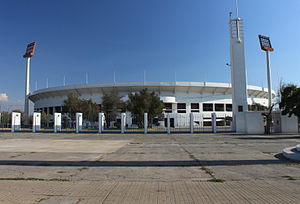Estadio Nacional Julio Martínez Prádanos
| El Nacional, El Coloso de Ñuñoa | |
 |
|
| Former names | Estadio Nacional (1938-2008) |
|---|---|
| Location | Av. Grecia 2001, Ñuñoa, Santiago, Chile |
| Coordinates | 33°27′52″S 70°36′38″W / 33.46444°S 70.61056°W |
| Owner | Municipality of Ñuñoa |
| Operator | Chiledeportes |
| Capacity | 48,665 (60.000+ in concerts) |
| Record attendance | 85,268 (Universidad de Chile-Universidad Católica, 29 December 1962) |
| Field size | 105 m x 68 m |
| Surface | Grass |
| Construction | |
| Broke ground | February 1937 |
| Opened | December 3, 1938 |
| Renovated | 2009-10 |
| Expanded | 1962 |
| Reopened | 12 September 2010 |
| Construction cost | $18,000,000 |
| Architect | Karl Brunner |
| Tenants | |
|
Chile national football team Universidad de Chile |
|
Estadio Nacional Julio Martínez Prádanos (originally known as Estadio Nacional) is the national stadium of Chile, and is located in the Ñuñoa district of Santiago. It is the largest stadium in Chile with an official capacity of 48,665. It is part of a 62 hectare sporting complex which also features tennis courts, an aquatics center, a modern gymnasium, a velodrome, a BMX circuit, and an assistant ground/warmup athletics track.
Construction began in February 1937 and the stadium was inaugurated on December 3, 1938. The architecture was based on the Olympiastadion in Berlin, Germany. The stadium was one of the venues for the FIFA World Cup in 1962, and hosted the final where Brazil defeated Czechoslovakia 3-1. It was notoriously used as a prison camp and torture facility by the military regime following the 1973 Chilean coup d'état.
In 2009, a complete modernization plan was unveiled for the stadium and surrounding facilities. President Michelle Bachelet said it would become the most modern stadium in South America.
The stadium was built on former farmland, donated in 1918 by farmer Jose Domingo Cañas. The first sporting event in the new stadium took place on 3 December 1938, with a friendly game between the Chilean club Colo-Colo and Brazilian club São Cristóvão. Colo-Colo won 6-3.
...
Wikipedia
